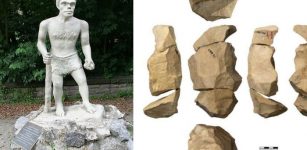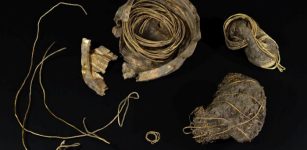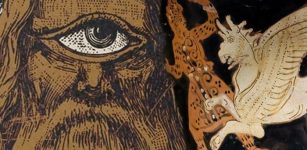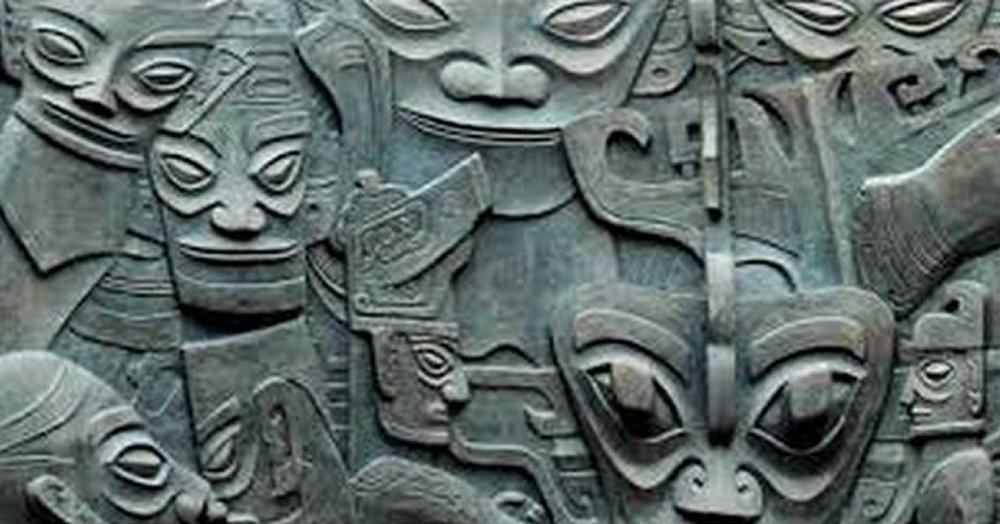Baffling Sanxingdui Civilization: Why Did These People Have Fascination For Eyes?
A. Sutherland - AncientPages.com - Sanxingdui are ruins of an ancient Chinese city with traces of a previously unknown culture dated to Bronze Age. The ruins are located in the region of Guanghan City, Sichuan Province.
This most remarkable place was first discovered in 1929 when a local farmer accidentally stumbled upon about 400 jade pieces, and these were the first Sanxingdui relics, which were discovered at the site. Since this time, the next generations of archaeologists have excavated and studied the Sanxingdui culture.
In 1986, a team of Chinese archaeologists discovered two major sacrificial pits filled with nearly
1000 bronze objects including hundreds of masks and heads, sun-shaped wares, bronze figures, bells, and a great variety of artworks made in jade, gold and stone. Many pieces of art display decorative dragons, snakes and birds, and other most curious relics that no one has ever seen.
However, no texts that could shed light on the secrets of the Sanxingdui culture were found.
Analysis of lead and other elements in the bronzes indicates sources similar to those of other cultures that lived along the lower reaches of the Yangtze River.
Altogether 120 mysterious Sanxingdui artifacts are dated from the 12th to 11th centuries BC. None of them was found marked with characters or and no historical records of the Sanxingdui culture have been found in the annals of nearby areas.
Among the artifacts, particularly intriguing are the heads (or masks), which do not appear to be human or even animal. They have very sharp features, exceptionally protruding eyes, and exaggerated ears and noses.
 Some masks portray the eyeballs sticking out of the mask-like pillars.
Some masks portray the eyeballs sticking out of the mask-like pillars.
Today, it is known that the great legacy of Sanxingdui cannot be entirely associated with the ancient kingdom of Shu, as it was previously thought.
Only a few references regarding the Shu kingdom exist in the early historical records of China until the 4th century BC. The Shu kingdom was subjugated by the state of Qin in 316 BC.

Bronze head (138 cm bred) with protruding eyes believed to be a depiction of Cancong, the semi-legendary first king of Shu. Image credit: Wikipedia
The mysterious Sanxingdui existed in this region much earlier, which was confirmed by recent archaeological excavations. But still, many archaeologists suggested the Sanxingdui culture to be part of the ancient kingdom of Shu.
Who were the people of Sanxingdui civilization? Where did they come from?
See also:
Dazu Rock Statues Of Clairvoyance And Clairaudience
Remarkable 2,000-Year-Old Smoke-Absorbing Lamps Reducing Pollution Discovered
Chang Woo Gow – The Kind And Intelligent Chinese Giant
According to the "Chronicles of Huayang" dated to the Jin Dynasty (265-420), the Shu kingdom was founded by Cancong. Cancong was described as having protruding eyes, a feature that is found in the figures of Sanxingdui. Other eye-shaped objects were also found which might suggest worship of the eyes.
Ancient Chinese myth says that Cancong was the mythical founder of the ancient Shu kingdom and the first ancestor of Shu kings. He taught techniques of silk production. His name means: Can – “silkworm” and cong means: “cluster”.
His appearance was strange, his eyes, for example, bulged in an upright position, which demonstrated his extraordinary powers. He was always seen in green clothes so he was called “Green God” or “God in Green Clothes”.
Written by - A. Sutherland - AncientPages.com Senior Staff Writer
Copyright © AncientPages.com All rights reserved. This material may not be published, broadcast, rewritten or redistributed in whole or part without the express written permission of AncientPages.com
Expand for referencesReferences:
A. P. Underhill, A Companion to Chinese Archaeology
L. Yang, Handbook of Chinese Mythology
Spara
Spara
Spara
Spara
Spara
Spara
Spara
Spara
Spara
Spara
Spara
Spara
Spara
Spara
Spara
Spara
Spara
More From Ancient Pages
-
 Incredible Shipwreck With Fascinating Cargo Found 1,200 Years After Sinking In Holy Land
Archaeology | Sep 22, 2022
Incredible Shipwreck With Fascinating Cargo Found 1,200 Years After Sinking In Holy Land
Archaeology | Sep 22, 2022 -
 6,500-Year-Old Copper Workshop Unearthed In Negev Desert
Archaeology | Oct 6, 2020
6,500-Year-Old Copper Workshop Unearthed In Negev Desert
Archaeology | Oct 6, 2020 -
 On This Day In History: Supernova Observed In Constellation Lupus By Chinese And Egyptians – On May 1, 1006 AD
News | May 1, 2016
On This Day In History: Supernova Observed In Constellation Lupus By Chinese And Egyptians – On May 1, 1006 AD
News | May 1, 2016 -
 25,000 Ancient Egyptian Statues, Ushabti Figurines And Artifacts From New Kingdom Cemetery Revealed For The First Time
Archaeology | Oct 26, 2023
25,000 Ancient Egyptian Statues, Ushabti Figurines And Artifacts From New Kingdom Cemetery Revealed For The First Time
Archaeology | Oct 26, 2023 -
 Neanderthals In Swabian Jura Used Complex Tool-Making Techniques 45,000 Years Ago
Archaeology | Sep 8, 2021
Neanderthals In Swabian Jura Used Complex Tool-Making Techniques 45,000 Years Ago
Archaeology | Sep 8, 2021 -
 Did Neanderthals And Modern Humans Meet In The Czech Republic 50,000 Years Ago?
Archaeology | Jun 17, 2017
Did Neanderthals And Modern Humans Meet In The Czech Republic 50,000 Years Ago?
Archaeology | Jun 17, 2017 -
 12,000-Year-Old Archaeological Evidence Of Human-Dog Friendship In Alaska
Archaeology | Dec 5, 2024
12,000-Year-Old Archaeological Evidence Of Human-Dog Friendship In Alaska
Archaeology | Dec 5, 2024 -
 Startling 3,000-Year-Old Gold Bowl Decorated With A Sun Motif Discovered Is A Truly Unique Artifact
Archaeology | Oct 17, 2021
Startling 3,000-Year-Old Gold Bowl Decorated With A Sun Motif Discovered Is A Truly Unique Artifact
Archaeology | Oct 17, 2021 -
 New Study Challenges The Beginning Of Civilization
Archaeology | Apr 11, 2022
New Study Challenges The Beginning Of Civilization
Archaeology | Apr 11, 2022 -
 Incredible Ancient Machines Invented By Hero Of Alexandria – An Engineer Far Ahead Of His Time
Featured Stories | Jun 3, 2020
Incredible Ancient Machines Invented By Hero Of Alexandria – An Engineer Far Ahead Of His Time
Featured Stories | Jun 3, 2020 -
 Spells, Charms, Erotic Dolls: Love Magic In The Ancient Mediterranean
Featured Stories | Oct 24, 2022
Spells, Charms, Erotic Dolls: Love Magic In The Ancient Mediterranean
Featured Stories | Oct 24, 2022 -
 Unique 1,600-Year-Old Gold Bead Found By Teenager In Jerusalem’s City Of David
Archaeology | Feb 9, 2023
Unique 1,600-Year-Old Gold Bead Found By Teenager In Jerusalem’s City Of David
Archaeology | Feb 9, 2023 -
 Arimaspians: Mysterious Mighty Warriors With One-Eye
Featured Stories | Mar 9, 2021
Arimaspians: Mysterious Mighty Warriors With One-Eye
Featured Stories | Mar 9, 2021 -
 Yakhchals: Ingenious Ancient ‘Refrigerators’ Could Store Ice In The Hot Desert
Ancient Technology | Sep 15, 2018
Yakhchals: Ingenious Ancient ‘Refrigerators’ Could Store Ice In The Hot Desert
Ancient Technology | Sep 15, 2018 -
 The Navajo People In The Land Of The Four Sacred Mountains
Civilizations | Jun 10, 2020
The Navajo People In The Land Of The Four Sacred Mountains
Civilizations | Jun 10, 2020 -
 Pharaoh Ramses Was Not One Of History’s Greatest Generals – New Study Ruins His Formidable Reputation
Archaeology | Jan 31, 2018
Pharaoh Ramses Was Not One Of History’s Greatest Generals – New Study Ruins His Formidable Reputation
Archaeology | Jan 31, 2018 -
 Mythical Temple Of Wingded Warrior God Haldi In The ‘City Of The Raven’
Civilizations | Jul 21, 2016
Mythical Temple Of Wingded Warrior God Haldi In The ‘City Of The Raven’
Civilizations | Jul 21, 2016 -
 Facial Reconstruction Of Ancient Inhabitants Of Sagalassos Make Them Almost Real
Archaeology | May 31, 2019
Facial Reconstruction Of Ancient Inhabitants Of Sagalassos Make Them Almost Real
Archaeology | May 31, 2019 -
 16 Meters Long Ancient Papyrus With Spells From The Book Of The Dead Found In Saqqara
Archaeology | Jan 19, 2023
16 Meters Long Ancient Papyrus With Spells From The Book Of The Dead Found In Saqqara
Archaeology | Jan 19, 2023 -
 Forgotten Ancient Kingdom Of Tuwana Is Hidden Among Ruins In Cappadocia
Civilizations | Mar 12, 2016
Forgotten Ancient Kingdom Of Tuwana Is Hidden Among Ruins In Cappadocia
Civilizations | Mar 12, 2016



